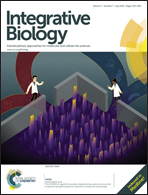Quantitative multivariate analysis of dynamic multicellular morphogenic trajectories†
Abstract
Interrogating fundamental cell biology principles that govern tissue morphogenesis is critical to better understanding of developmental biology and engineering novel multicellular systems. Recently, functional micro-tissues derived from pluripotent embryonic stem cell (ESC) aggregates have provided novel platforms for experimental investigation; however elucidating the factors directing emergent spatial phenotypic patterns remains a significant challenge. Computational modelling techniques offer a unique complementary approach to probe mechanisms regulating morphogenic processes and provide a wealth of spatio-temporal data, but quantitative analysis of simulations and comparison to experimental data is extremely difficult. Quantitative descriptions of spatial phenomena across multiple systems and scales would enable unprecedented comparisons of computational simulations with experimental systems, thereby leveraging the inherent power of computational methods to interrogate the mechanisms governing emergent properties of multicellular biology. To address these challenges, we developed a portable pattern recognition pipeline consisting of: the conversion of cellular images into networks, extraction of novel features via network analysis, and generation of morphogenic trajectories. This novel methodology enabled the quantitative description of morphogenic pattern trajectories that could be compared across diverse systems: computational modelling of multicellular structures, differentiation of stem cell aggregates, and gastrulation of cichlid fish. Moreover, this method identified novel spatio-temporal features associated with different stages of embryo gastrulation, and elucidated a complex paracrine mechanism capable of explaining spatiotemporal pattern kinetic differences in ESC aggregates of different sizes.


 Please wait while we load your content...
Please wait while we load your content...